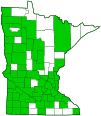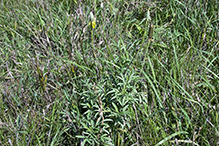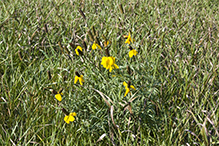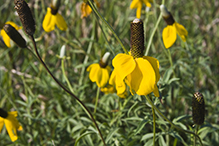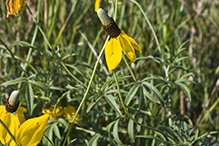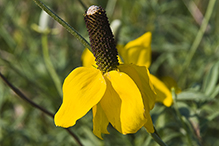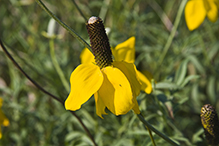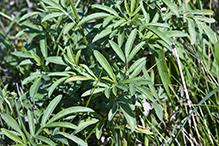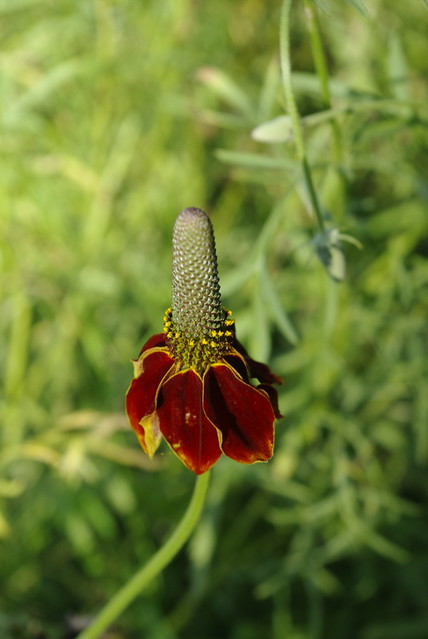long-headed coneflower
(Ratibida columnifera)
Conservation • Description • Habitat • Ecology • Use • Distribution • Taxonomy
Conservation Status |
|
|||||||
| IUCN Red List | not listed |
|||||||
| NatureServe | N3N5 - Vulnerable to Secure SNR - Unranked |
|||||||
| Minnesota | not listed |
|||||||
Description |
||
Long-headed coneflower is an erect, perennial forb that rises on a solitary stem or, more commonly, multiple stems from a taproot. It can be 12″ to 40″ tall but usually reaches no more than 24″ in height. The stems are erect, unbranched or occasionally branched above the middle, grooved, hairy, and rough to the touch. The leaves are alternate, spreading, ¾″ to 6″ long, and 5 ⁄16″ to 2⅜″ wide. Lower leaves are on leaf stalks up to 2″ long, upper leaves are stalkless. The leaf blades are deeply divided into 3 to 15 lobes (pinnatifid) which may be again divided into lobes (bipinnatifid). The ultimate lobes are narrowly linear lance-shaped or narrowly oblong egg-shaped, up to 2⅜″ long, and 1 ⁄32″ to ⅝″ wide. They have 1 inconspicuous vein and may be pointed or blunt at the tip. The upper and lower surfaces are covered with short, appressed, stiff hairs and are dotted with glands. The margins are untoothed. The inflorescence is a single, 2″ to 3″ long flower head at the end of each stem and branch. A single, multi-stemmed plant may have up to 15 flower heads. The flower heads are held well above the leaves on prominently ribbed stalks that may be 2½″ to 10″ long or more. Each flower head is composed of 4 to 12, usually 6, ray florets and a central disk with 200 to 400 or more disk florets. The ray florets are yellow, lance egg-shaped to elliptic inversely egg-shaped, ¼″ to 1⅜″ long, and ⅛″ to ⅝″ wide. They droop downward at the base of the receptacle. The receptacle is shaped like a column, ⅜″ to 2″ long, and ¼″ to ½″ wide. The disk florets are 1 ⁄32″ to 3 ⁄32″ wide with greenish-yellow corollas that are purplish-tinged toward the tip. The fruit is a dark purple achene. |
||
Height |
||
12″ to 40″ |
||
Flower Color |
||
Yellow ray florets. |
||
Similar Species |
||
|
||
Habitat |
||
Dry. Prairies, pastures, roadsides, railroads. Full sun. |
||
Ecology |
||
Flowering |
||
June to September |
||
Pests and Diseases |
||
|
||
Use |
||
|
||
Distribution |
||||
|
Sources |
|||
| 5/7/2023 | ||||
Nativity |
||||
Native |
||||
Occurrence |
||||
|
||||
Taxonomy |
|||
| Kingdom | Plantae (Plants) | ||
| Division | Tracheophyta (Vascular Plants) | ||
| Subdivision | Spermatophytina (Seed Plants) | ||
| Class | Magnoliopsida (Dicots) | ||
Order |
Asterales (Sunflowers, Bellflowers, Fanflowers, and Allies) | ||
Family |
Asteraceae (Sunflowers, Daisies, Asters, and Allies) | ||
| Subfamily | Asteroideae | ||
| Supertribe | Helianthodae | ||
| Tribe | Heliantheae (Sunflowers and Allies) | ||
| Subtribe | Rudbeckiinae (black-eyed Susans, coneflowers, and prairie coneflowers) | ||
| Genus | Ratibida (coneflowers) | ||
Subordinate Taxa |
|||
Some plants have maroon or purplish ray florets. These are more common in the southwestern states. Some authorities treat this as a separate variety or form, var. pulcherrima or f. pulcherrima. |
|||
Synonyms |
|||
Ratibida columnaris Rudbeckia columnifera |
|||
Common Names |
|||
longhead prairie coneflower long-headed coneflower Mexican hat upright coneflower upright prairie coneflower |
|||
Glossary
Bipinnatifid
Twice pinnatifid. Cut deeply into lobes with each lobe also cut into deep lobes.
Chaff
Thin, dry scales or bracts; the bracts on the receptacle of the flower head of some Asteraceae.
Corolla
A collective name for all of the petals of a flower.
Pinnatifid
Deeply cut, more than half way to the midrib but not to the midrib, into lobes that are spaced out along the midrib; the lobes do not form separate leaflets.
Receptacle
The thickened, upper part of a flower stalk to which flowers or flower parts are attached. In composite flowers, the part on which the flowers are borne. In accessory fruits the receptacle gives rise to the edible part of the fruit.

Visitor Videos |
|||
Share your video of this plant. |
|||
| This button not working for you? Simply email us at info@MinnesotaSeasons.com. Attach a video, a YouTube link, or a cloud storage link. |
|||
Other Videos |
|||
| Ratibida columifera - Präriesonnenhut MrKatzengreis |
|||
About
Published on Jul 21, 2012 No description available. |
|||
| Ratibida columnifera conservation PLANTS272 |
|||
About
Uploaded on Jul 28, 2011 Susan describes the conservation benefits of 'Stillwater' upright prairie coneflower, Ratibida columnifera, a perennial wildflower native to North America with conservation applications. For more information on Ratibida, log onto the Plants database or contact jim.jacobs@mt.usda.gov. |
|||

Visitor Sightings |
|||||
Report a sighting of this plant. |
|||||
| This button not working for you? Simply email us at info@MinnesotaSeasons.com. Be sure to include a location. |
|||||
|
|||||
MinnesotaSeasons.com Sightings |
|||||

|
Created: Last Updated: © MinnesotaSeasons.com. All rights reserved. |

